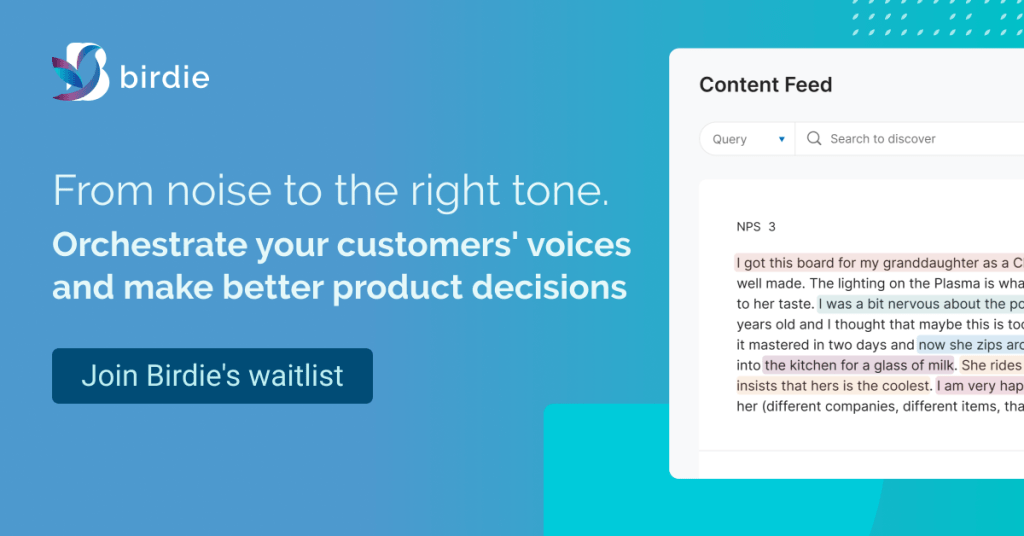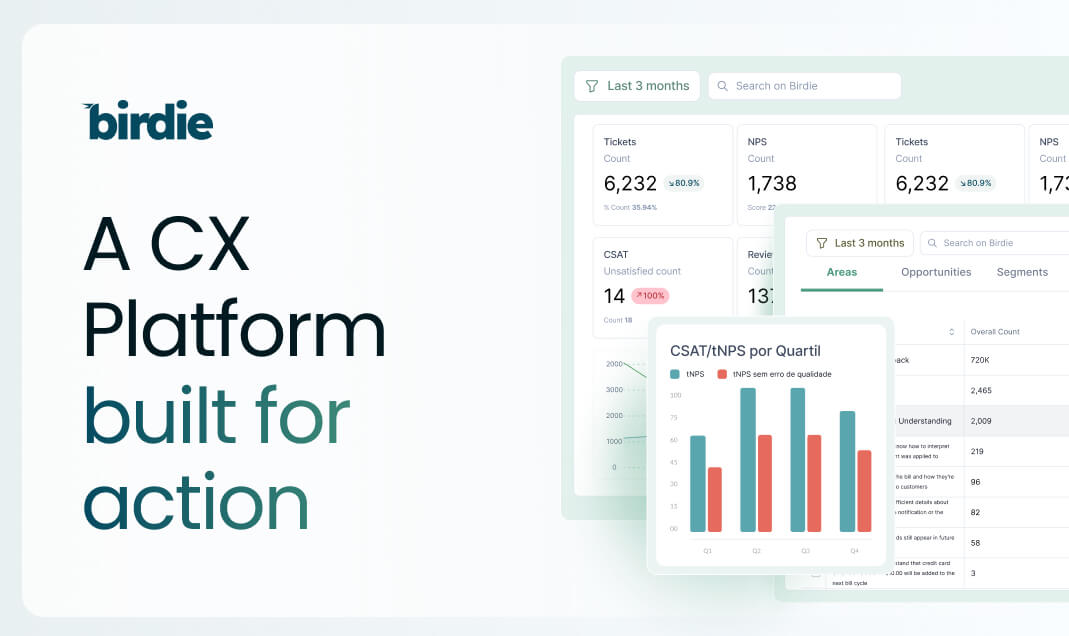

Everybody knows that user experience must be a top priority when it comes to creating a successful product. Delivering a good user experience is key to ensuring good business and product metrics, such as revenue, MAU, and satisfaction, just to name a few.
But what does a good experience mean to users? How can you understand what your customers expect, like, and dislike? Listening to user feedback is critical - and that's why you need to invest in customer feedback analytics tools.
Although it is still very common for product teams to run NPS surveys, conduct user interviews, and analyze customer support tickets every once in a while, the number of companies that choose to implement user feedback tools is increasing, especially among companies with thousands of customers and a high volume of unstructured feedback.
In fact, the world's leading product school, Reforge, has a whole session in their Mastering Product Management course dedicated to the importante of setting up a customer feedback management system to improve your product team's performance.
Our goal with this blog post is to tell you:
- What is customer feedback analytics
- The importance of feedback analytics tools for product teams
- The difference between feedback analytics, product analytics and feedback management
- Key elements of a feedback analytics tool
Feedback analytics and its importance for product strategy
Feedback analytics is nothing but applying the concept of data analytics to user feedback.
Analytics can be defined as the process of discovering, interpreting, and communicating significant patterns in data. By doing so to customer feedback, it is possible to understand how people feel about your product and their experience with it "” and that is really valuable.
Feedback analytics tools have the ability to break customer feedback, like a user review or conversation, down into smaller subsets of data - we call topics - to make it easier to be interpreted, quantified, and analyzed in order to generate insights that can be actionable.
Although feedback analysis is more commonly used by customer support teams to analyze how agents are performing their activities, automate responses, and increase support performance, there is a huge value in using it to have an overview of product gaps and opportunities based on user feedback.
Once you have a clear overview, that can be used for multiple elements of product management: to recalibrate your product strategy, discover hypotheses to explore in product discovery, identify the reach and impact of features for roadmap prioritization, and more, all to increase product performance and usability.
Evidence and metrics are also powerful pieces of product management, especially when it comes to stakeholder negotiation. A feedback analytics tool can be the source of information to help you make more informed decisions, have solid arguments in leadership meetings, and keep track of product evolution.
Why should you care about customer feedback analytics?
- Learn about customer desires, frustrations, and expectations
Feedback analytics tools will show gaps and opportunities to be explored based on qualitative customer input - both spontaneous and requested.
This helps to add color to your metrics and analyses and to bring more depth about reasons and the context that drove users to have a behavior.
With a feedback analytics tool, a product team can understand common patterns and real user intentions to deliver insights to help improve the product.
- Track emerging trends, opportunities, and issues "“ without recency bias
A customer feedback analytics platform ensures that all feedback collected is in one place, which makes it easier to monitor the volume of feedback associated with a specific feature request, issue, or activity.
By setting up alerts in your feedback analysis tool, it's much easier for a product team to monitor the pulse of the customer and quickly take action if a trending issue emerges.
At the same time, having a single system of record for feedback with a layer of analytics can help avoid recency bias: the perception that just because something emerged recently and suddenly it is more important than something that has been consistently growing.
- Empower an evidence-based product culture
According to Lisa Orr, Sr. Product Manager at Zapier, "mature product teams frequently use evidence to support their decisions".
Using evidence, especially from user feedback, makes it easier for product managers to justify their decisions, estimate and measure the impact of new features, and get empowered to build a culture where product teams drive product strategy and prioritization using the customer as a source for decision-making.

The difference between Feedback Analytics, Product Analytics, and Feedback Management
Although the three topics are related, it is important to specify the differences to make the best out of each concept.
Feedback analytics vs. Product analytics
The difference here is quite simple: a feedback analytics tool collects qualitative feedback from different sources. On the other hand, product analytics is solely related to behavior analysis and user engagement with the product - quantitative data - and no feedback is required.
Product analytics data can be used as a segmentation source for feedback analytics tools, allowing companies to relate qualitative feedback to user behavior and identify and to combine both to create better results for a product growth strategy.
Feedback analytics vs. Feedback management
This is a bit more controversial. There is a lot in common between feedback analytics and feedback management, and some overlaps between these tools as both have the end goal of managing feedback.
The main difference is that the later has feedback collection and response as a core element while feedback analytics focuses mostly on generating value out of feedback that is already available - either collected via feedback management tools or other tools that also generate feedback input.
Choosing the best option for you depends on your goal: do you want to increase your feedback volume or improve how you engage with the customer? Get a feedback management tool! You already have a lot of feedback and want to get more value out of it "“ using it to inform product strategy? Get a feedback analytics tool.
The importance of a feedback analytics tool for customer-centric organizations
A feedback analytics tool is critical for product teams. But no product is completely successful without other stakeholders "“ such as marketing, customer success, and sales "“ and without a product-centric and customer-centric culture. Closing the feedback loop relates to that.
A feedback loop consists of a build, measure, and learn cycle. The model was first shared by Erick Ries, entrepreneur and writer of the book The Lean Startup Methodology. In a nutshell: he established that products can be continuously improved so it gets to the point where the product is exactly what the targeted customer wants.
But how can a product be continuously improved? Simple: with a continuous process of listening to user feedback. Our needs as customers change and evolve, new competitors arise, new technologies appear, and all of that impacts the perception of your product as something valuable.
Truly customer-centric product teams need to run continuous discovery programs in order to continuously connect users' perceptions with desired outcomes, identify opportunities, test hypotheses, gather feedback, analyze it, and start all over again.
Truly customer-centric organizations involve different stakeholders in that process and make sure that every team is aligned with the idea of building a product that addresses customer needs.
Truly customer-centric cultures adopt a product-centric approach to deliver a product that solves a customer need without becoming a feature factory or a project-based solution, empowering product teams with customer data to make decisions that will generate value.
Key elements customer feedback analytics tools
Being such a relevant solution for product teams, it's important to understand what makes a good feedback analytics tool for product teams. Let's take a look at what are the key elements to take into consideration when evaluating a product feedback analytics tool:
- Its ability to integrate and analyze qualitative data from multiple sources: User feedback comes in multiple forms, from multiple sources: NPS surveys, support tickets, notes from sales calls, user interviews, reviews, and more. Analyzing only one source of data means having a biased and incomplete view of the customer's perception.
- Its ability to "remove the noise" and create filters and segmentations: A good feedback analytics solution is able to identify which comments are not relevant and sift the wheat from the chaff. It should also be able to use and combine other metadata "“ such as user behavior, user demographics, and others "“ as filters to segment the feedback in order to get more accurate insights, i.e. what is in common between churning users, high-returning users, lost clients, promoters, etc.
- Its ability to categorize feedback with efficiency: it's hard to manually tag thousands of comments. It's even harder to do that while maintaining a logical taxonomy hierarchy. Luckily, there's technology today that can help with that. AI-powered tagging gives product teams the ability to categorize millions of comments in seconds; it also has the benefit of adding intelligence to this process, suggesting similar terms to add to a topic or new topics based on context and similarity and constantly learning with new topics that you create to customize the solution to your needs.
- Its analytics and visualization capabilities:a lot of traditional analytics tools, like Tableau and PowerBI, have limited capabilities when it comes to analyzing feedback. It's important to understand how easy it is to visualize the overall data, trends, and volumes, but also to be able to easily go deeper into the qualitative aspect.
- Its collaboration functionalities: building a great product and a great customer experience means having multiple teams accessing and collaborating with each other over the data and the insights. Understanding how easy is to share, comments, and interact in the platform - and how much it costs - it's really important when you're trying to implement a customer-centric culture.
Why chosing Birdie as your feedback analytics tool for product management?
Birdie is a platform that delivers all the components of a great feedback management solution: feedback river, feedback system of record, and feedback analytics. Combined, it is able to make the job of centralizing, classifying, analyzing, and sharing customer feedback to generate top-notch actionable insights easier for product teams.
Our AI-enhanced categorization module allows teams to automate and improve the process of categorizing comments and lets different teams collaborate and extract valuable insights from the data. Here is how different roles can take advantage of our feedback analytics tool powered by AI:
- Product Managers can use customer feedback as a source to decide on what to prioritize for product discovery and roadmaps
- Product Marketing teams may analyze and refine product positioning considering customers' perceptions and opinions
- UX specialists can spend less time collecting data and more quality time analyzing customers' reviews and coming up with improvements
- CX teams: the AI platform simplifies customer feedback categorization and makes it easier to close the loop. Customer experience professionals can focus on solving critical issues and improving client retention while also becoming a more relevant source for strategic product decisions.
If you wish to learn more about our platform don't hesitate to sign up for our waitlist to try Birdie for free.








